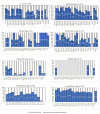Febrile illness of bacterial etiology in a public fever hospital in Egypt: High burden of multidrug resistance and WHO priority Gram negative pathogens
- PMID: 35601951
- PMCID: PMC9113693
- DOI: 10.18683/germs.2022.1308
Febrile illness of bacterial etiology in a public fever hospital in Egypt: High burden of multidrug resistance and WHO priority Gram negative pathogens
Abstract
Introduction: Contemporary emergence of multidrug resistance (MDR) urges regular updates on circulating pathogens and their antimicrobial resistance profiles. We aimed to identify the burden of MDR and World Health Organization (WHO) priority Gram negative pathogens among patients admitted with febrile illness to Abbassia Fever Hospital, a major Public Fever Hospital in Egypt. The carbapenemase- and extended spectrum beta-lactamases (ESBLs)-encoding genes carried by the isolates were also identified.
Methods: A total of 9602 clinical specimens were collected from febrile patients during 2018 and 2019. The recovered bacterial isolates were examined for antimicrobial susceptibility using disk diffusion test. Susceptibility to colistin was tested using E-test. ESBLs production was phenotypically and genotypically analyzed.
Results: A total of 790 bacterial isolates (612 Gram negative and 178 Gram positive) were recovered. A percentage of 77.6%, and 62.9% of the Gram negative and positive isolates showed MDR phenotype, respectively. WHO priority pathogens were abundant, including carbapenem-resistant (CR) Enterobacterales (105/187; 56.1%) and CR glucose non-fermenters (82/187; 43.8%) such as: A. baumannii (55; 29.4%), P. aeruginosa (27; 14.4%). Carbapenemase- and ESBLs-encoding genes were detected in 56.1% and 30.8% of Enterobacterales and in 43.8% and 46.3% of glucose non-fermenters, respectively. Antimicrobials such as fosfomycin and chloramphenicol retained good activities against MDR Gram negative pathogens.
Conclusions: This study highlights the regional burden of MDR and priority Gram negative pathogens. The obtained data are of relevant medical importance for implementation of evidence-based antimicrobial stewardship programs and for tailoring the existing empirical treatment guidelines.
Keywords: ESBLs; Febrile illness; Gram negative; WHO priority pathogens; multidrug resistance.
GERMS.
Conflict of interest statement
Conflicts of interest: All authors – none to declare.
Figures


References
-
- O’Grady NP, Barie PS, Bartlett JG, et al. Guidelines for evaluation of new fever in critically ill adult patients: 2008 update from the American College of Critical Care Medicine and the Infectious Diseases Society of America. Crit Care Med. 2008;36:1330–49. doi: 10.1097/CCM.0b013e318169eda9. - DOI - PubMed
LinkOut - more resources
Full Text Sources
